The Station Blog
Capsaicin a Quick Fix for Trigeminal Neuralgia 27/08/2015
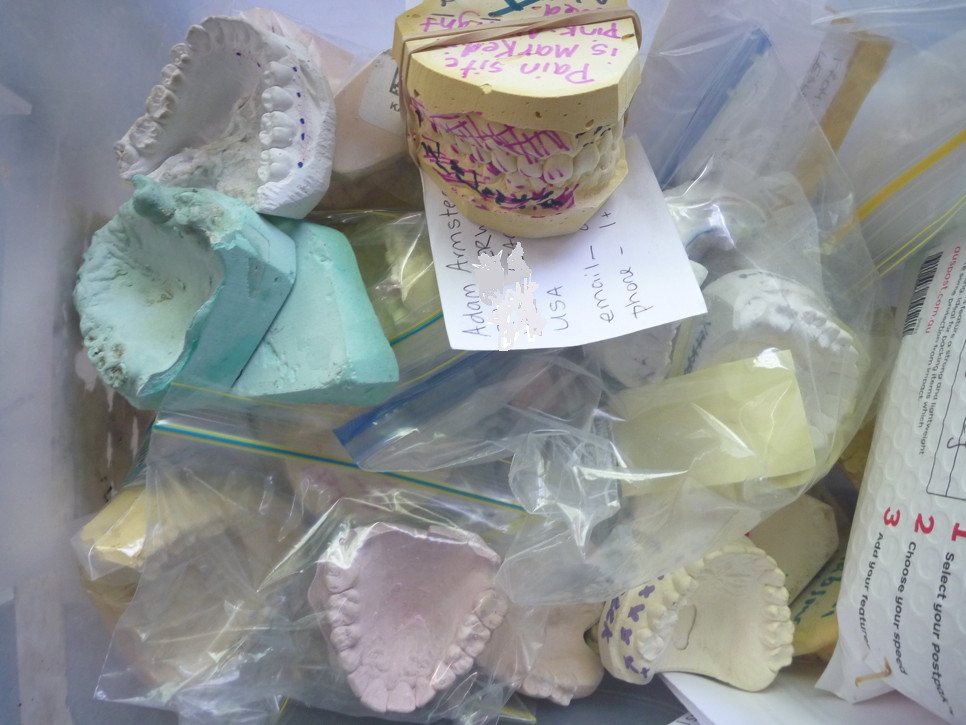 We have now helped over 150 people (with I suspect about 50% success..which isn't bad) One thing that become clear is the enormous variation shown by this condition which appears to be closely related to having had chicken pox (Herpes zoster) as a child). People who have had little intervention (dental or surgical) seem to be the best candidates for success. Here's our "Fang Drawer" - dental casts from people for whom we've
made the critical mouthguards.
We have now helped over 150 people (with I suspect about 50% success..which isn't bad) One thing that become clear is the enormous variation shown by this condition which appears to be closely related to having had chicken pox (Herpes zoster) as a child). People who have had little intervention (dental or surgical) seem to be the best candidates for success. Here's our "Fang Drawer" - dental casts from people for whom we've
made the critical mouthguards.
Using Home Biogas 29/12/2022
Four years ago we invested in a Home Biogas digester from an Israeli based alternative energy group (www.homebiogas.com). We were the classic “early adopters” - and as a result had all the early adopter’s issues! Basically it is an anaerobic digester which relies on microorganisms to convert food waste into methane, which is stored in a weighted gas bag on top of the digester tank.
So far, so good. However, no starter culture was provided - Home Biogas hadn’t developed one yet. Cow manure was described as the correct starter for the process, as cattle rely on an array of microorganisms to break down cellulose to sugars (and methane - cow farts). So we set out for the nearest dairy (rather rare in the Daintree) and collected as many cow pats as we could (mostly rather dry) and loaded them in, filled the digester with water and some veggie scraps and waited, and waited. Eventually the gas bag started to inflate. Turned on the gas tap, applied a match, and a weak blue flame appeared - oops! Turns out that the CO2 bacteria had won the fight against the methane generating bacteria (methanogens). Plus we should have used fresh cow shit! So we empty a lot of smelly liquid from the digester, clean it, and start again.
OK - now we need fresh cow shit, so we rang Mungalli Biodynamic Dairy, in Malanda (about 200km south of us) - and yes they were happy to provide 60 litres of the stuff, fresh from the morning milking. So off we went - (it’s a long drive), and yes, three 20 litre white buckets with lids, full of that steaming brown stuff (which seemed anxious to escape) waiting for us. Stomped the lids down, and load into the car for the trip back (OK some did escape!). Poured the 60 litres into the digester, added water and waited..and waited..and waited. Eventually we gave up - the digester became a large fat black-and-green blob outside the kitchen window. After about a year, we noticed some stirrings, and the gas bag starting to inflate. So again tried lighting the gas - and we got a strong (and very hot) flame! - seems that over the year the methanogens had won!
So now - we are getting a very reliable source of gas, and do most of our cooking with it. It seems to be almost pure methane. We now take great care to homogenise all the scraps that we feed it (affectionally known as Fatso) - as that achieves much faster digestion, and makes clean-out simple (should that be necessary) as there are no chunky bits in the digester.
However, even getting to do the homogenising wasn’t plain sailing - we found a great device, a Kambrook Power Drive stick mixer - very powerful and with a stainless steel mixing head. Fantastic. So off we went a-homogenising. That first attempt killed the mixer. So Kambrook (Breville) honoured their warranty and a replacement arrive in a week. Try again - Took care to remove lumpy bits, and the replacement lasted a month, before stripping out a small plastic coupling. Breville came to the rescue again - and the penny dropped. Their beautiful flower-shaped stainless steel cutter guard had windows in it. These filled with vegetable fibre and eventually jammed the motor. Solution - get rid of them so there would be no holes. The modified guard has worked a treat, can’t jam and we’ve been using it for over a year now with no issues. I’m sure Breville will be grateful. We are. Now we're cooking with (bio)gas!
Metsulfuron-methyl impact on native vegetation in the Daintree lowlands 20/08/2015
by Dr Hugh Spencer
 As part of a control program for Singapore Daisy Sphagneticola
(Wedelia) triblobata, using metsulfuron-methyl herbicide, in the
lowland tropical environments of the Daintree, we needed to assess the
impact of the herbicide on native vegetation, as the extensive nature
of the weed invasion prevented selective application. We assessed the
impact on 80 native species exposed to the herbicide of which 62 were
resistant, and 18 were killed after a spray application that would
reliably kill the Singapore daisy plants. The native sensitive species
by and large were soft leaved pioneer species that could readily
re-colonize the area once the Singapore daisy had been removed. This
resistance permits a far easier approach to control, as the extreme
care that is usually required to avoid spraying native seedlings, can
be greatly relaxed. Additionally metsulfuron-methyl is proving to be a
highly effective herbicide for controlling an unusually wide variety of
other environmental weeds, including Lantana and Syngonium, in the
region. Click here to read the
whole article.
As part of a control program for Singapore Daisy Sphagneticola
(Wedelia) triblobata, using metsulfuron-methyl herbicide, in the
lowland tropical environments of the Daintree, we needed to assess the
impact of the herbicide on native vegetation, as the extensive nature
of the weed invasion prevented selective application. We assessed the
impact on 80 native species exposed to the herbicide of which 62 were
resistant, and 18 were killed after a spray application that would
reliably kill the Singapore daisy plants. The native sensitive species
by and large were soft leaved pioneer species that could readily
re-colonize the area once the Singapore daisy had been removed. This
resistance permits a far easier approach to control, as the extreme
care that is usually required to avoid spraying native seedlings, can
be greatly relaxed. Additionally metsulfuron-methyl is proving to be a
highly effective herbicide for controlling an unusually wide variety of
other environmental weeds, including Lantana and Syngonium, in the
region. Click here to read the
whole article.
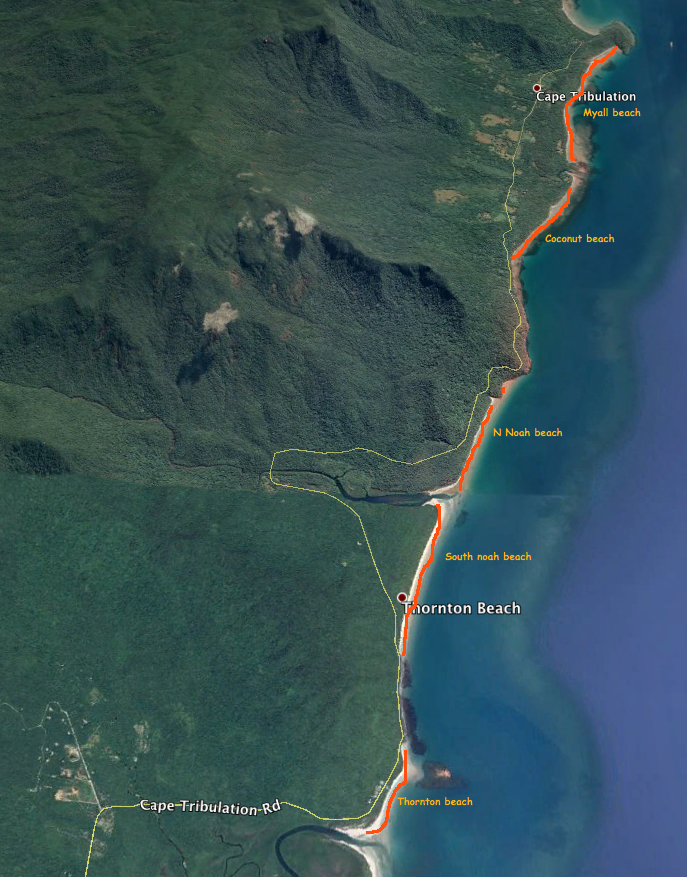 Singapore daisy on the Cape Tribulation Coast beaches.
By 2018, we have managed to eliminate Singapore daisy from over 8 Km of beaches in the region.
Clear beaches: the orange lines indicate the major beaches that we have
been able to clear of Singapore Daisy".
Singapore daisy on the Cape Tribulation Coast beaches.
By 2018, we have managed to eliminate Singapore daisy from over 8 Km of beaches in the region.
Clear beaches: the orange lines indicate the major beaches that we have
been able to clear of Singapore Daisy".

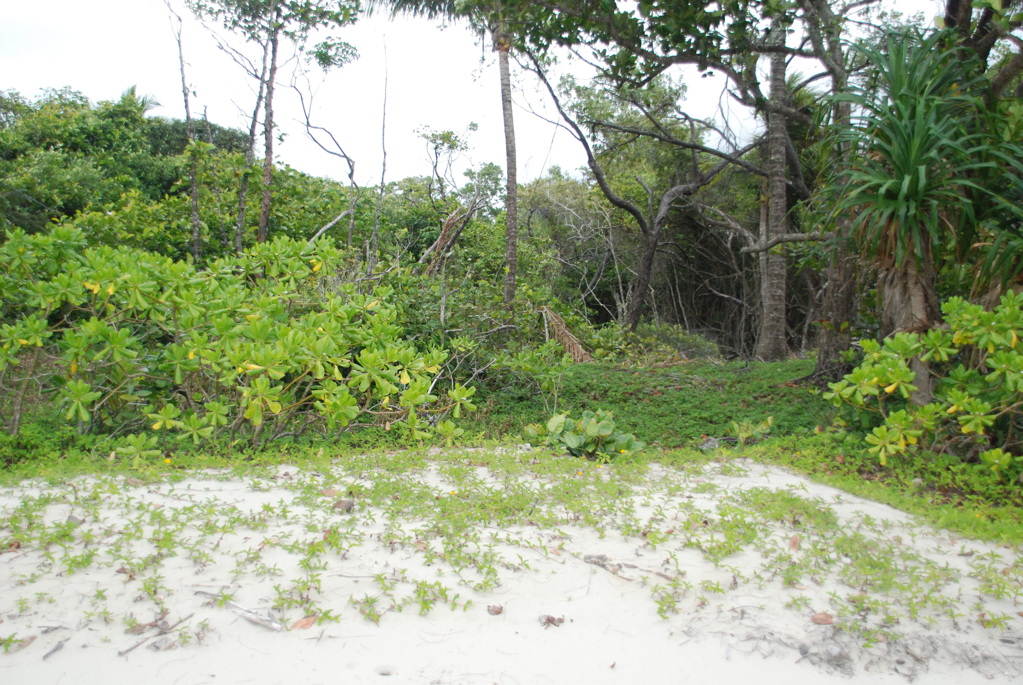 When we started, the beaches looked like this or worse (now they are clear). These infestations have been here for over 30 years.
When we started, the beaches looked like this or worse (now they are clear). These infestations have been here for over 30 years.
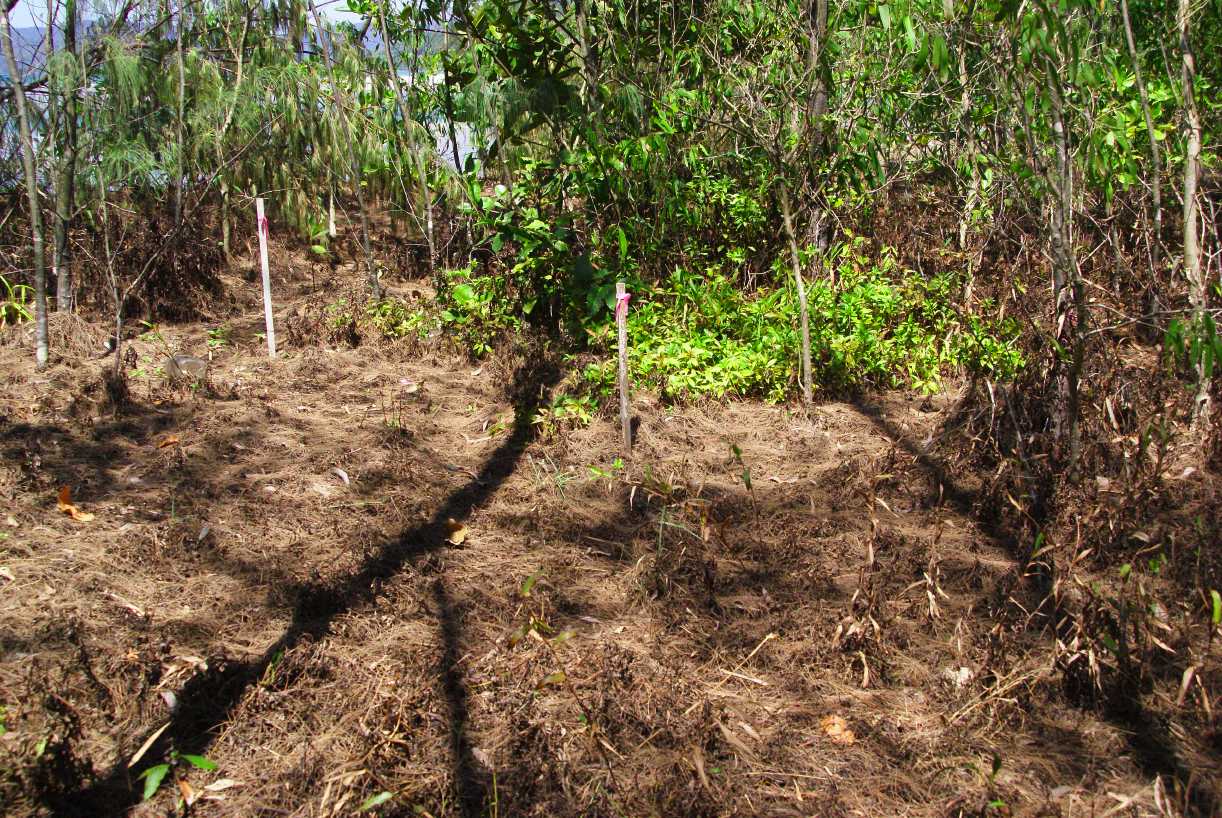 In some areas it was knee deep and was suppressing regeneration of native littoral species, severely impacting the natural littoral forest. The mat of dead Singapore daisy provides a good mulch for natural regeneration (The green patch near the stakes was a reference patch)
It will require yearly "spotting" forays with a backpack spray, but luckily Singapore daisy produces few seeds. However there are up-stream infestations - and these are harder to control, given the increasing numbers of absentee landlords here (who don't want anyone on their properties). We have also managed to eliminate almost all the the
roadside infestations between Cape Trib and the ferry. What's amazing is how
little damage occurs to the environment by using this herbicide.
In some areas it was knee deep and was suppressing regeneration of native littoral species, severely impacting the natural littoral forest. The mat of dead Singapore daisy provides a good mulch for natural regeneration (The green patch near the stakes was a reference patch)
It will require yearly "spotting" forays with a backpack spray, but luckily Singapore daisy produces few seeds. However there are up-stream infestations - and these are harder to control, given the increasing numbers of absentee landlords here (who don't want anyone on their properties). We have also managed to eliminate almost all the the
roadside infestations between Cape Trib and the ferry. What's amazing is how
little damage occurs to the environment by using this herbicide.
Renewable Energy RAPS Systems in the Daintree Lowlands 20/08/2015
by Dr Hugh Spencer
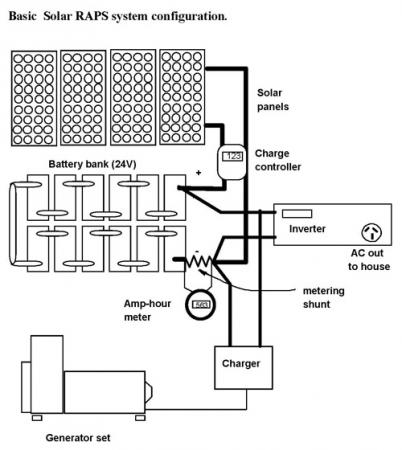 Lead acid batteries are the storage mainstay of renewable
energy systems. The technology has been in existence for over a
century, and except in details, is essentially unchanged. Basically it
consists of two plates of lead bathed in dilute sulphuric acid.
Charging (passing an electric current between the plates) converts the
plate on one side to lead dioxide and the other plate to spongy lead.
Discharging converts both plates to lead sulphate, and in the process
generates an electric current in an external circuit. This cycle can be
repeated for hundreds and in some cases thousands of times before there
is no more lead sulphate available to be converted, at which time the
battery is totally useless.
Lead acid batteries are the storage mainstay of renewable
energy systems. The technology has been in existence for over a
century, and except in details, is essentially unchanged. Basically it
consists of two plates of lead bathed in dilute sulphuric acid.
Charging (passing an electric current between the plates) converts the
plate on one side to lead dioxide and the other plate to spongy lead.
Discharging converts both plates to lead sulphate, and in the process
generates an electric current in an external circuit. This cycle can be
repeated for hundreds and in some cases thousands of times before there
is no more lead sulphate available to be converted, at which time the
battery is totally useless.
De-sulphation technology for lead-acid batteries has been in
existence for some 15 years, and is based on the concept that a brief
high-current pulse applied to a lead acid storage cell is able to
prevent the accretion of lead sulphate crystals (produced as part of
the discharge process) into large crystals or groups of crystals that
become disconnected from the active electrode of the cell, and hence no
longer contribute to the storage capacity of the battery. How this
occurs appears to be highly speculative although it is postulated that
the pulse, if strong enough and with a fast enough onset time, will
cause the molecular bonds of the lead sulphate (PbSO4) to resonate, in
a manner analogous to a guitar string being plucked, and this reduces
the tendency to produce larger crystals. Whatever the mechanism, these
electron micrographs of dismantled cell plates which have been operated
with a de-sulphator, show a substantially smaller crystal grain size
than those operated without one.
Thus the anticipated effect of the de-sulphator on battery
capacity would be that the reduction in crystal size and improvement in
the resultant crystal connectivity to the active plates, should be
reflected in changes (increase) in battery capacity.
Lead acid battery chemistry is in fact exceedingly complex and
it is only in the last 10 or so years that a fuller understanding of
the conditions involved in charging and discharging are transforming
our understanding of their capabilities and limitations. Each battery
type has a set of unique attributes that can have a major effect on its
performance under different operating conditions. This variability in
battery type and chemistry greatly complicates studies such as this
one, but as de-sulphator technology is really only beginning to be
investigated, studies such as this one help establish the parameters
for their appropriate application.
We have now managed to get over well 1000 A pulses - pretty impressive -
we've had several interns (from UK and China) work on this - but we really
need someone who can take it to commercial production.. Despite the push
for lithium - AGM lead acid battery systems are still the best - and
there is no shortage of lead - but there is a shortage of lithium (and the impacts of mining)!
With care Lead acid batteries can last well over 15 years.
Click here to read the whole article.
Phenology of Ficus variegata in a Seasonal Wet Tropical Forest at Cape Tribulation, Australia 20/08/2015
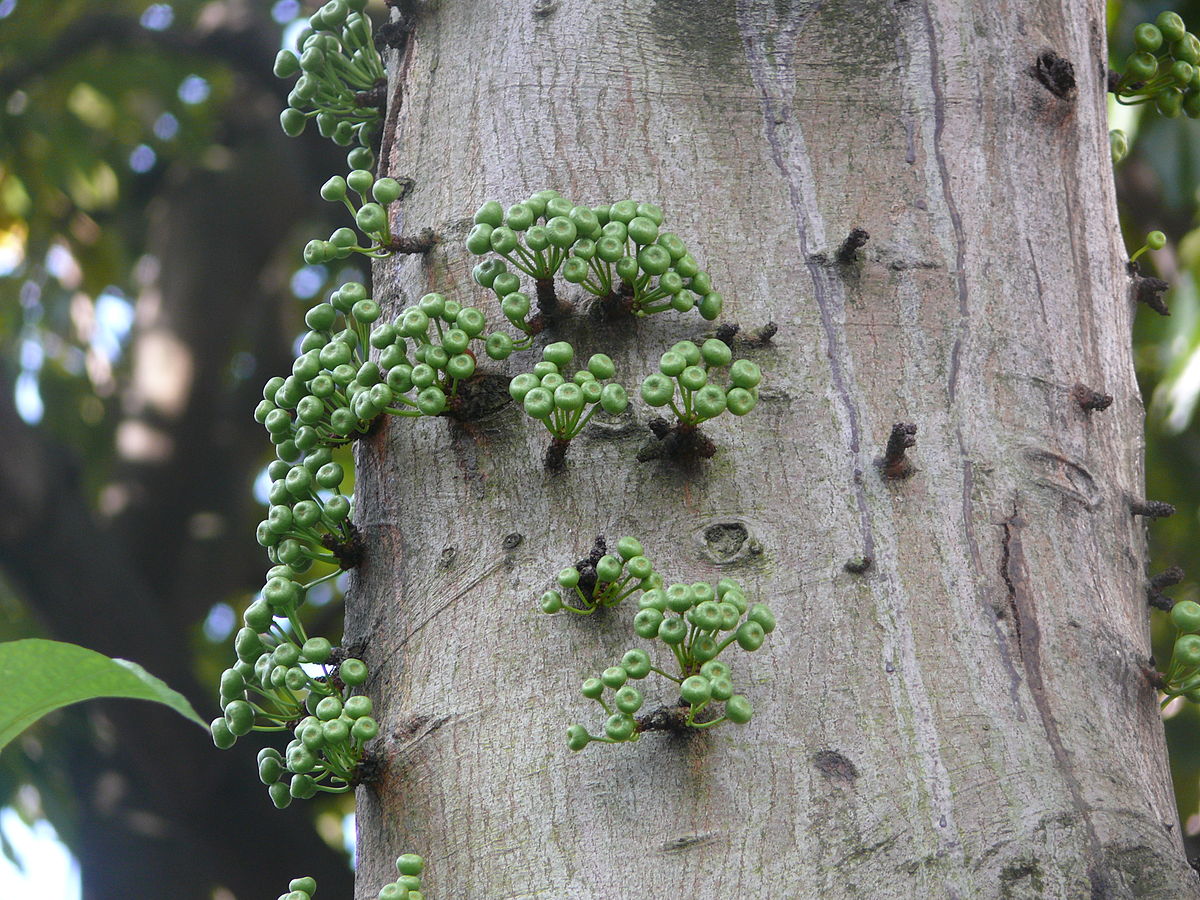 Phenology
of Ficus variegata in a Seasonal Wet Tropical Forest at Cape
Tribulation, Australia, by Hugh Spencer, George Weiblen and Brigitta
Flick, 1996 Blackwell Publishing.
Phenology
of Ficus variegata in a Seasonal Wet Tropical Forest at Cape
Tribulation, Australia, by Hugh Spencer, George Weiblen and Brigitta
Flick, 1996 Blackwell Publishing.
Abstract:
We studied the phenology of 198 mature trees of the dioecious
fig Ficus variegata Blume (Moraceae) in a seasonally wet tropical rain
forest at Cape Tribulation, Australia, from March 1988 to February 1993.
Leaf production was highly seasonal and correlated with
rainfall. Trees were annually deciduous, with a pronounced leaf drop
and a pulse of new growth during the August-September drought. At the
population level, figs were produced continually throughout the study
but there were pronounced annual cycles in fig abundance. Figs were
least abundant during the early dry period (June-September) and most
abundant from the late dry season (October-November) through the wet
season (December-April). The annual peak in reproduction actually
reflected two staggered peaks arising from gender differences in fig
phenology. In this dioecious species, female and male trees initiated
their maximal fig crops at different times and flowering was to some
extent synchronized within sexes. Fig production in the female
(seed-producing) trees was typically confined to the wet season. Male
(wasp-producing) trees were less synchronized than female trees but
reached a peak level of fig production in the months prior to the onset
of female fig production. Male trees were also more likely to produce
figs continually. Asynchrony among male fig crops during the dry season
could maintain the pollinator population under adverse conditions
through within- and among-tree wasp transfers.
Phenology of Ficus variegata in a Seasonal Wet Tropical Forest
at Cape Tribulation, Australia
Hugh Spencer, George Weiblen and Brigitta Flick
Journal of Biogeography, Vol. 23, No. 4, Fig Trees
and Their Associated Animals (Jul., 1996), pp. 467-475
Published by: Blackwell Publishing
Now, that was quite a while ago... With AGW we are seeing the pattern
seriously starting to fray, with figs now showing numerous fruiting
episodes instead of the fairly well-defined pattern we found 30
years ago. We need someone to collate the data we have accumulated
since so we can publish it! It is one of the few long-time
phenological studies.
A Brief History of the Daintree Lowland Rainforest 20/08/2015
by Dr Hugh Spencer
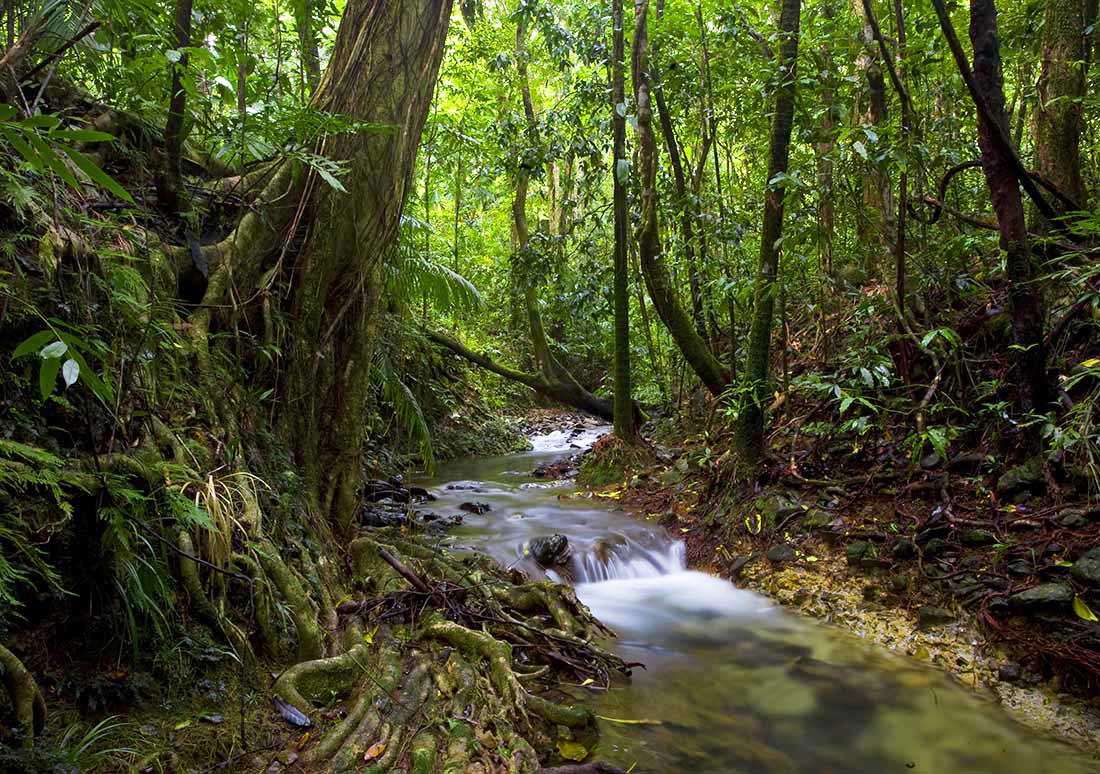 Home to the southern cassowary, one of the world's largest
flightless birds, crocodiles, fruit bats and a host of other animals
and plants, the Daintree lowlands have become one of
Australia's most beautiful icons.
Home to the southern cassowary, one of the world's largest
flightless birds, crocodiles, fruit bats and a host of other animals
and plants, the Daintree lowlands have become one of
Australia's most beautiful icons.
With an unbroken history of over 100 million years, the
tropical rainforests of the Daintree lowlands are, miraculously, still
surviving and inspiring people such as Robin. However their future is,
like so much of the world's remaining rainforests, dire. The Daintree
lowlands, for that is the really unique and unprotected area, is under
immediate threat from, not logging, but piecemeal development.
For, you see, the Daintree has had a long history of attempts
at human settlement since the beginnings of the 1900s. After the Great
Depression, settlers were encouraged to go there as leasehold farmers,
to "fill the north, clear the forests and set up farms.
Luckily, this ancient forest proved tougher than the farmers, and their
leaseholds were bought out by an enterprising local real estate agent,
and freeholded, and subdivided into over 1100 two to four acre blocks
with the blessing of the then Queensland Government, in the late 1970's.

